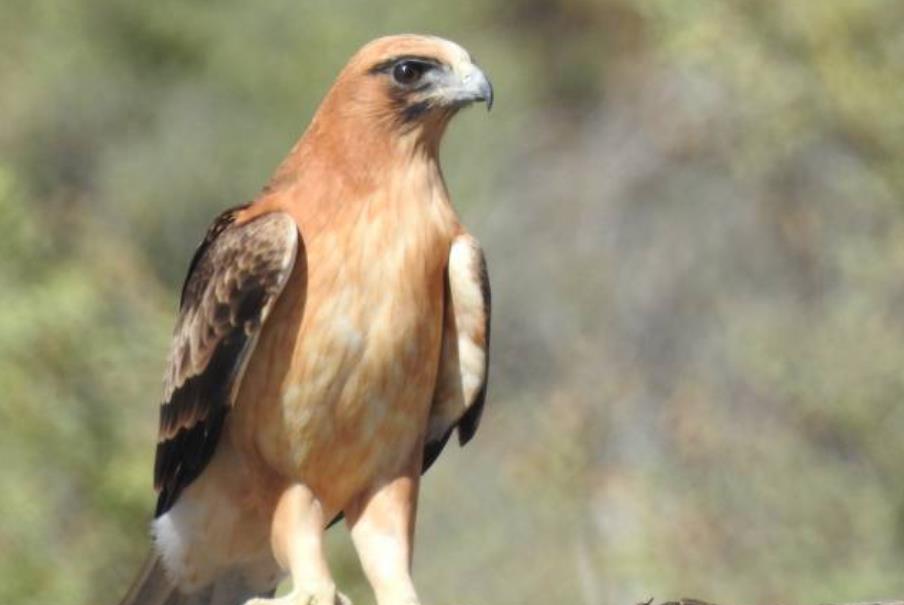Behavior: In both light and dark color phases, the little eagle is a rather sedentary bird, with each pair spending much of the day soaring over their wooded terrain alone or together. On sunny days, it will spiral tightly on thermal air currents, sometimes rising to great heights. In flight, both phases can be distinguished from the similar-looking Whistling Kite by their stouter build, short square tail, and broader, more rounded wings, which are turned slightly up at the tip, not drooped. Little Eagles have a short, erectile crest and are the only eagles other than the Wedge-tailed to have fully feathered ‘legs’ down to the toes.
Little eagles usually kill and eat their prey on the ground or carry it up to a stout tree branch to escape the attention of piratical and scavenging birds such as kites, crows, or ravens. They pluck and eat alternately, anchoring prey in their talons and pulling it apart with the bill. However, the pairs probably mate for life. Before and during breeding, the male performs steeply undulating display flights over his territory, calling loudly, and circles with the female, diving down at her from above while she rolls to present claws. Occasionally, a pair will also perch near one another or next to trees, face each other, and bow and peer; the purpose of this display is not known. At the nest, the female does nearly all the incubating and brooding and she feeds the young with prey brought by the male; the male provides for the family and early each morning brings fresh leaves for the nest.
Diet: The Little Eagle is a leisurely hunter who prefers live prey but will occasionally eat carrion, including dead rabbits. It searches for prey by flying and gliding over wooded country, or by watching from a commanding position in a nearby tree where it rests for long periods. Its prey includes small mammals, reptiles, large insects, and occasionally other birds. In a country infested with rabbits, their young, about one-third grown, are its chief food.
Size: The male bird size is about 480–490 mm, and the female is about 550–560 mm in length.
Identification: Both sexes are similar. There are two color phases. Light-phase birds are light and dark brown above, with black flight feathers and paler bands on wing coverts. Head, neck, and upper breast russet; small erectile crest with black-tipped feathers; black streak below eye. The tail is square-cut grey-brown above with dark brown bars; it is nearly white at the tip. Underparts are mainly white or pale buff, with a few chestnut streaks. Dark-phase birds have upper parts chiefly dark brown with paler bands on wing coverts. The underparts are mainly dark brown with black streaks. In both phases, the eyes are brown; bill is dark brown or grey with grey cere; feet feathered down to pale blue-grey toes; and the claws are dusky. The immature underparts are chestnut in light-phase birds and darker brown than adults in the dark phase. The downy young is snowy white; eyes pale brown; cere yellow; feet flesh.
Vocalizations: The little eagle normally calls a soft whistling note of two or three syllables, with the second and third syllables shorter and lower in pitch. Also a longer series of whistles, starting slowly and ending rapidly, falling in pitch. Trilling screams in display flight; peeping notes with prey.
Nesting and Breeding: Nesting and breeding occur in August–November in southern Australia. The little eagle builds or reuses a large stick nest about 800 mm in diameter, lined daily with green leaves, placed high in a tree, about 10–45 meters above ground.
Eggs and Incubation: The bird usually lays one or two eggs; white tinged with blue, with red-brown streaks and blotches; rounded-oval, about 55 x 44 mm. The incubation period is about 30–35 days, mostly for females. Usually, only one young fledgling emerges in about 50 days.
Distribution: The little eagle is found in wooded country over much of mainland Australia. Sedentary or nomadic.
Races: There are two races: one in Australia and the other, smaller, in Papua New Guinea.
Related Reading: Northern Goshawk – The Apex Predator of the Avian World







